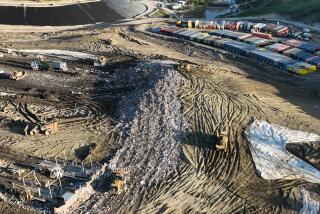Haze at Grand Canyon Blamed on Power Plant
WASHINGTON — A coal-burning power plant owned in part by the city of Los Angeles was identified by the Environmental Protection Agency on Tuesday as a major source of haze that impairs winter views in the Grand Canyon.
The finding ignited a fierce battle in the Bush Administration over whether to require the Arizona plant to install costly cleanup equipment.
The EPA, forced to act by a lawsuit from environmental groups, based its finding on a National Park Service study that traced sulfur emissions from the plant to the canyon’s northern edge, 12 miles away, and to its center, 80 miles away.
High Percentages
“The study concluded the Navajo Generating Station contributes approximately 40%, on average, to the observed haze and as much as 60% to 70% during the worst episodes,” the EPA said in a statement.
Under an agreement reached with the Environmental Defense Fund and other groups, the EPA has six months to decide what level of antipollution technology, if any, is warranted to improve visibility in the canyon. Estimates for extensively curtailing emissions from the plant’s smokestacks range from $200 million to $1 billion, costs that would have to be paid by utility customers and federal taxpayers.
The case has broad implications for other national parks whose visibility was ordered protected by Congress 12 years ago in an action that has been largely ignored until now.
The Arizona plant’s six owners, a consortium that includes the Los Angeles Department of Water and Power and the U.S. Bureau of Reclamation, assailed the Park Service study and called for a new evaluation of the causes of the canyon’s deteriorating visibility.
Cost Objections
“Wet scrubbers (in smokestacks) would run in the neighborhood of $1 billion. . . . This is too costly to pass on to consumers without absolute proof that the station is a significant contributor to haze in the canyon,” said officials of the Salt River Project, operator of the power plant and a 22% owner.
Endorsing that statement, DWP spokeswoman Dorothy Jensen added, “Ceasing operation of the plant a few days each winter might provide the most dramatic reduction in emissions that the plant could make.” The DWP is a 21% owner.
The owners received support from Interior Secretary Manuel Lujan Jr., who said he wanted the National Academy of Sciences to review the Park Service study. Lujan’s Interior Department includes both the Park Service and the Bureau of Reclamation, a 24% owner of the plant.
“We stand ready to take the appropriate steps to minimize the impact of the Navajo facility, once those steps have been identified,” Lujan said in a statement that privately infuriated Park Service officials.
The Bush Factor
Bob Yuhnke, an Environmental Defense Fund attorney who spearheaded the lawsuit against the EPA, said he is “very pleased by the EPA announcement” but “worried about the battle raging in the Administration, as reflected in the Lujan statement.”
Yuhnke said President Bush ultimately may have to resolve conflicts involving Lujan, EPA Administrator William K. Reilly and Budget Director Richard G. Darman, who is expected to raise questions about the federal costs of cleaning up the Arizona plant.
“I think it is a question of whether or not Bush is willing to pay the price of protecting our national parks and cleaning up the environment,” Yuhnke said.
As part of its six-week, $2-million study, the Park Service injected a chemical tracer into the Navajo plant’s three 775-foot smokestacks so the plume of sulfate particles could be tracked. The tracer chemical was detected at Hopi Point, the main visitor area on the north rim of the park, the EPA said.
More to Read
Sign up for Essential California
The most important California stories and recommendations in your inbox every morning.
You may occasionally receive promotional content from the Los Angeles Times.









